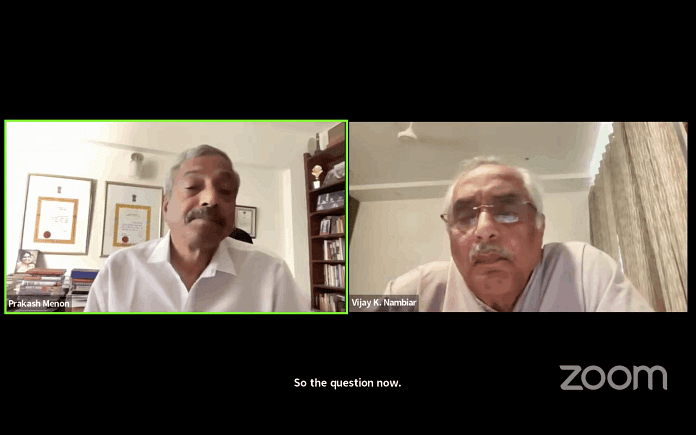New Delhi: China making inroads into India’s subcontinental neighbourhood — Nepal, Bhutan, Myanmar, Sri Lanka, Maldives, and Seychelles — is aimed at confining India within the subcontinent to slow down India’s growth to power, said army veteran Lt. Gen. Prakash Menon.
Menon, director of the Strategic Studies Programme and Professorial Fellow at the Takshashila Institution, was speaking at a webinar ‘Interpreting China’s Strategy on the Northern Borders’ Thursday.
Organised by the Institute of Chinese Studies, New Delhi, with ThePrint as a media partner, the webinar was chaired by Vijay K. Nambiar, former ambassador of India to China and honorary fellow at the Institute of Chinese Studies.
“(India’s) power, if it grows at the speed that is unrestricted by…such things (China’s aggressive actions on the northern border), would become a threat if India tilts or shifts its weight (towards China), because if that happens, it is a major disadvantage for China,” Menon said.
“I think what we need to understand in the beginning itself is that the (China’s) military instrument, because of its instrumental nature, has to finally influence the mind of the decision-makers on the other side,” Menon added.
He said that this use of various instruments available to China — military, economic or diplomatic — is based on the country’s aim to realise its goal in the “domain of the psychological”.
In essence, China’s actions are aimed at influencing the minds of India’s political leadership, he said.
Also read: Proposed Aksai Chin railway line will multiply China’s military capacity, says army veteran
Restricting India to the subcontinent
According to Menon, China is using the northern borders with India as ‘pinch points’ or ‘pressure points’ to apply “small amounts of military force” to keep India’s political and military energy and resources “sucked up”.
“This is part of its larger strategy of trying to keep India restricted to the subcontinent. For several decades, it has been using and continues to use Pakistan as its southpaw (to keep India busy),” said Menon.
China’s strategy towards India, Menon said, has evolved. In the beginning, China declared there must be peace with India — this was the time when China focused on laying low and made quite a few agreements with India — while also developing its own connectivity and infrastructure, including military infrastructure in the provinces of Xinjiang and Tibet.
China, he added, since 2010 or so, started small interventions in the northern borders, patrolling along the Line of Actual Control (LAC), stopping Indian patrols, holding banner drills claiming that these regions were a part of China, in an effort to draw India’s attention to the northern borders and expend political and military resources. Following this, he added, China would back down, negotiate and restore the status quo.
This continued till the incident at Galwan, Menon said. Galwan changed India’s position within the Quadrilateral Security Dialogue (Quad) — which consists of the US, Japan, India and Australia.
On the night of 15-16 June, 2020, Indian and Chinese troops faced-off at Galwan valley in eastern Ladakh. At least 20 Indian soldiers were killed during the clashes, as reported by ThePrint earlier.
Menon asserted that India was hesitant to join this grouping until the incidents at Galwan.
Galwan gave the policy-makers in India clarity on China’s position, he said. He further highlighted how India has accepted that it would have to carry the weight of China’s aggressive actions in the northern borders, but where it can achieve cooperation is in the maritime sphere — especially with the Quad.
India and its partners have started a flurry of joint naval or maritime exercises in a manner that has never been seen before, Menon added. While these exercises may have no declared enemy, the psychological impact on China is one of worry due to increasing maritime cooperation between India, the US and its allies, he said.
India’s geographical endowment
Describing India’s geographical endowment, specifically peninsular India “jutting out” into the Indian Ocean, which places it in the centre of strategic trade routes that are essential for China, Menon said, “A very large part of China’s trade goes to the country (through the Indian Ocean), energy especially and resources from the West to the East, and manufactured goods the other way around.”
He also highlighted that if the other nations in the Indo-Pacific, including India, are able to “unite and cooperate” in the maritime areas, this could pose the “greatest strategic to China”, apart from nuclear weapons.
“That (cooperation of different nations in the Indo-Pacific) is what China is most worried about,” Menon said.
This imagined threat has driven China’s growing naval power. “It is no match yet to the naval power of the United States of America nor of its allies and, so, also of India, in terms of its geographic location, because it is in the Indian Ocean that all of these things (trade) have to pass,” Menon added.
India’s strategic geographical location is also strengthened by the Andaman and Nicobar Islands, Menon said, which overlooks the Strait of Malacca.
The 900-kilometre-long Malacca Strait links Europe and West Asia with East Asia. About 40 percent of the world’s trade and nearly 80 percent of China’s total crude oil imports is carried out through the Strait, according to Reuters.
“Geography is not on China’s side in these terms. Its Eastern seaboard and its trade routes are vulnerable,” Menon said.
(Edited by Smriti Sinha)
Also read: India ‘fifth superpower of the world’, says African Union Chair, thanks Modi for inclusion in G20



